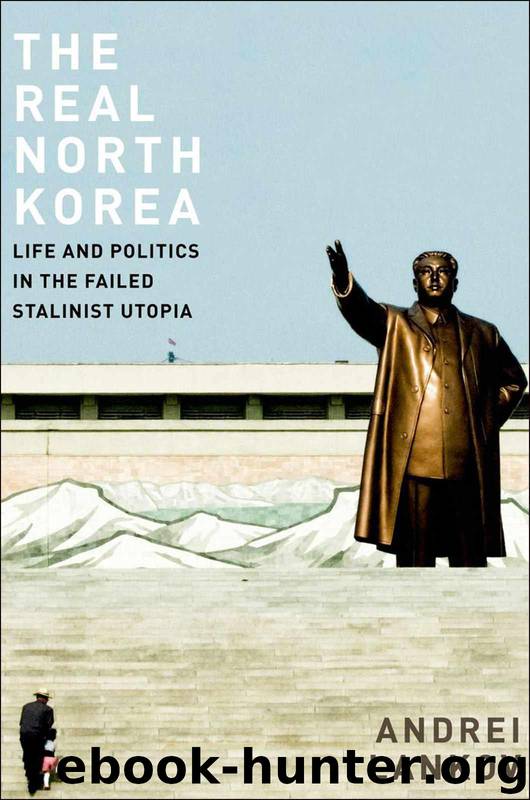The Real North Korea: Life And Politics In The Failed Stalinist Utopia by Lankov Andrei

Author:Lankov, Andrei [Lankov, Andrei]
Language: eng
Format: mobi
Published: 0101-01-01T00:00:00+00:00
THE CITY OF MONUMENTS
Pyongyang is usually presented as an ancient city. And this, in a sense, is really the case. The area has been the site of a major settlement for nearly two millennia. However, the present Pyongyang was built almost from scratch in the mid-1950s.
This was largely the result of a major US bombing campaign that reached its height in 1952. The US command had hoped to bomb the North Korean government into submission, and by the end of the war, some 90 percent of the city ceased to exist and most of its population had fled to the countryside.
Reconstruction began in the 1950s. From the very beginning, the new government wanted to build an exemplary Communist city free from reactionary traces of the feudal and imperialist past (Kim Il Sung was quite explicit when he said, “There were many defects in Pyongyang because it was built in an uncultured and lopsided way, under Japanese imperial rule”). The skyline that emerged owed much to the late Stalin’s Soviet Union. Indeed, many parts of the 1950s and 1960s Pyongyang look exactly like a Soviet provincial city of the same period. At the time, many important positions in the construction industry were occupied by Soviet Koreans who would later be purged and accused of “wrecking.”
The center of 1960s Pyongyang was called Stalin Street (eventually renamed Victory Street). However, a new round of major construction began in Pyongyang in the 1970s. This was a time when most of the major landmarks of modern North Korea were erected. On the hill overlooking the Taedong River, a great statue of Kim Il Sung was erected. Behind that, the museum of Korean Revolution was built. Not far from there one could see the Mansudae Theater, where the exemplary revolutionary operas were performed in the 1970s. The large central square, predictably named after Kim Il Sung, was topped off with a mammoth People’s Study House. Most of these structures broke with earlier Soviet heritage and were built in a mock traditional style (but still with a touch of characteristic megalomania).
On the opposite side of the Taedong River, a Tower to the Juche Idea was erected in 1982. The general shape of the Chuch’e Tower duplicates that of the Washington monument in the US capital, but exceeds it in size. The tower is 150 meters high and is crowned with a 20-meter-high torch that is illuminated at night. The tower includes 25,550 granite blocks—one for each day Kim Il Sung had lived by the time the monument was unveiled.
And of course there were a great many high-rise apartment buildings constructed in the 1970s and 1980s. Some of these high-rise quarters are actually off-limits for normal Pyongyangites, including a large district near the 35-story Koryo Hotel. This is where Central Committee officials live behind high fences.
However, contrary to what a short-term visitor might think, the majority of Pyongyangites do not live in these apartments. One merely has to go to the Juche Tower in order to get a real idea about how the living quarters of Pyongyang are structured.
Download
This site does not store any files on its server. We only index and link to content provided by other sites. Please contact the content providers to delete copyright contents if any and email us, we'll remove relevant links or contents immediately.
| Arms Control | Diplomacy |
| Security | Trades & Tariffs |
| Treaties | African |
| Asian | Australian & Oceanian |
| Canadian | Caribbean & Latin American |
| European | Middle Eastern |
| Russian & Former Soviet Union |
The Secret History by Donna Tartt(16675)
The Social Justice Warrior Handbook by Lisa De Pasquale(11495)
Thirteen Reasons Why by Jay Asher(7806)
This Is How You Lose Her by Junot Diaz(5802)
Weapons of Math Destruction by Cathy O'Neil(5051)
Zero to One by Peter Thiel(4839)
The Myth of the Strong Leader by Archie Brown(4796)
Promise Me, Dad by Joe Biden(4459)
Beartown by Fredrik Backman(4438)
Stone's Rules by Roger Stone(4426)
How Democracies Die by Steven Levitsky & Daniel Ziblatt(4424)
The Fire Next Time by James Baldwin(4353)
100 Deadly Skills by Clint Emerson(4089)
A Higher Loyalty: Truth, Lies, and Leadership by James Comey(4043)
Rise and Kill First by Ronen Bergman(4026)
The David Icke Guide to the Global Conspiracy (and how to end it) by David Icke(3899)
The Farm by Tom Rob Smith(3881)
Secrecy World by Jake Bernstein(3791)
The Doomsday Machine by Daniel Ellsberg(3742)
